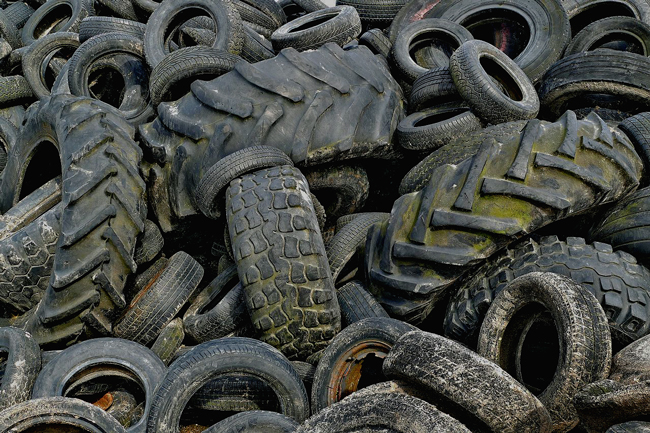
Cement maker Lafarge gets approval to burn old tires instead of coal
by Michael Tutton, The Canadian Press

The approval allows about 20 tonnes of tires day to be burned as fuel for Lafarge's cement plant in Brookfield, N.S.

With up to 20 tonnes of spent tires set alight every day, the year-long pilot project will use thousands tires. PHOTO: Gerd Danigel/Wikimedia
HALIFAX—Nova Scotia is shifting from recycling tires to burning them, prompting anger from environmental groups and a company that has invested $5 million to find fresh uses for the scrap rubber.
The province announced July 6 it’s going to pay LaFarge Canada about $105 per tonne—up to about $2,100 daily—in a one-year pilot project that will burn the tires to make cement in the company’s Brookfield plant.
Mike Chassie, the vice-president of C and D Recycling, said his Halifax firm is losing a third of its supply of about one million tires annually.
He says over time that could devastate an industry dedicated to turning the rubber into construction fill.
“This is hugely disappointing for the entire recycling industry in Nova Scotia. This will directly affect the tire recycling industry and could kill it,” he said in an interview.
The regulatory approval of the pilot project was announced by Iain Rankin, the Liberal minister of the environment, who defended it as a good way to reduce the use of coal at the factory about 14 kilometres south of Truro.
“It’s diversion. It’s energy recovery. The company is using it as a replacement for coal they’re currently using. You’ll see a reduction in carbon emissions,” he said.
Divert NS, the agency that chooses companies for waste diversion, offered an emailed statement saying it remained “proud of Nova Scotia’s culture of recycling.”
It said burning tires is an accepted technology around the world, and noted that it has to pay Chassie’s firm about $200 per metric tonne—close to double the burning fee.
Mark Butler, the director of the Ecology Action Centre, said he was baffled by the province’s approval of the project.
He said there are few environmental principles more basic than the one that recycling should be preferred over incinerating plastic or rubber.
In addition, he said if the tires were instead used under roads or other fill, they have the potential to be re-used again decades from now.
“I’m dumbfounded. Usually we’re told we have to do something because there are jobs. This time I thought we had jobs on our side, we had science on our side,” he said.
“Yet the government seems to choose the interests of a large corporation over some Nova Scotia-based businesses … and our concerns.”
When Nova Scotians purchase tires, they pay an environmental fee of $4.50 for a regular new tire, while truck tires have a fee of $13.50.
The existing brochure on the Divert NS website says consumers pay the fee “to support the costs of tire collection and processing for recycling.”
But Chassie said the government is now using the fees to subsidize a multinational corporation’s fuel costs rather than his investment in recycling.
Rankin repeatedly rebuffed questions from reporters on the issue and responded that his job was simply to assess the environmental evidence.
A spokeswoman for Divert NS said the agency wanted to diversify the possible uses of the tires.
“A single market is not a good situation, and we wanted to diversify to reduce the risk,” wrote Carolyn Pierce in an email.
Rob Cumming, environment director of LaFarge Canada, said critics need to bear in mind that the fuel is being used to produce cement—an important part of the country’s infrastructure.
“We need to be looking at lower carbon options. … Scrap tires represent a 30 per cent reduction in carbon emission for every tonne of fuel,” he said.
“It’s a wonderful use of scrap tires.”
He also said that 60 to 70 people work at the plant in unionized jobs, and keeping costs low is important.
“This is an important piece of the puzzle for us in terms of being sustainable going forward.”
Meanwhile, Chassie said a battle still lies ahead, as one of the government’s conditions allows for the formation of a community liaison—which he said could produce fervent local opposition.
The province has also said the project will be assessed after a year to see if the carbon emissions levels from the plant were reduced as a result.
The approval allows tires to be a maximum of 15 per cent of the total fuel, or about 20 tonnes of tires, each day.
The firm is required to carry out continuous monitoring of emissions, and to make the test results public.